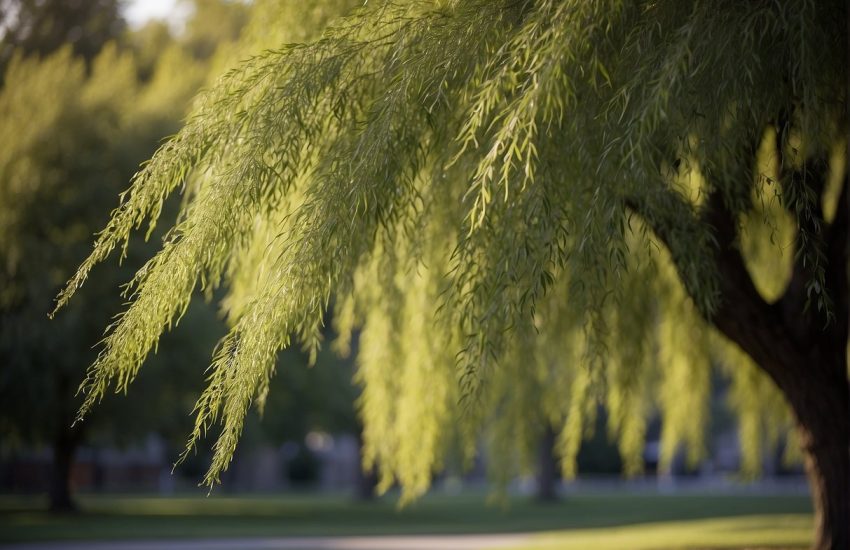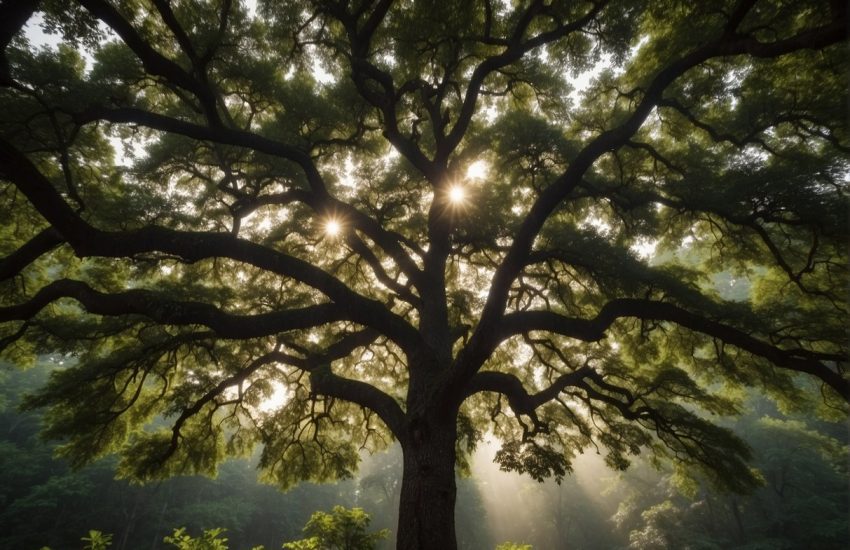The Best Ornamental Trees to Grow in Georgia
If you’re interested in growing ornamental trees in Georgia, whether they’re flowering trees, trees with vibrant foliage, or small ornamental trees, you’ve come to the right place. Here are 20 types that will do well for any area in Georgia with suitable growing conditions.
Flowering Dogwood
The Flowering Dogwood used to be far more widespread, but it’s only become more appealing. Once spanning from southern coastal Maine to the Mississippi River and northern Florida, this flowering tree is native to northern Mexico and eastern North America. You can expect early white and pink spring flowers and vibrant scarlet fall foliage. One of the most attractive trees in eastern North America, it is a small shrub or tree with 20 to 40 feet high with single or multiple trunks, a short trunk, and almost horizontal branches. You can easily recognize one by its size, flat crown, cream-colored spring flowers with 4 petals, and oval leaves that are 3-6in long and 1-3in wide. It grows in hardiness zones 5 through 9.
Witch Hazel
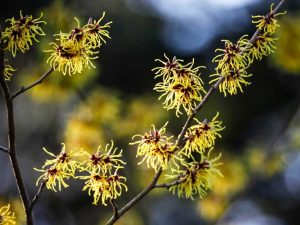
You might first know Witch Hazel as an astringent for the skin. Flowering in autumn, it is easily recognizable by its bright yellow, aromatic flowers and crinkly petals. It has dark green, oval leaves with wavy edges and a height of 10-20ft. It grows in planting zones 3 through 9 with slightly acidic, moist, well-drained soil and full sun to partial shade. Three species exist in North America: big leaf, Ozark, and American or common witch hazel. This shrub or tree grows 9.84 to 24.6ft high and has oval leaves that are alternately arranged, 1.96 to 5.9in long and 0.98 to 3.93in wide.
Azaleas
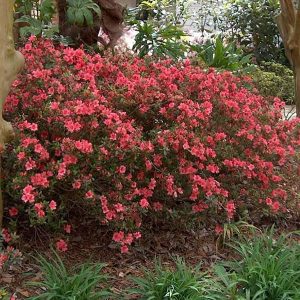
Native to North America, Europe, and Asia, the most popular are the Christmas azaleas, which have bright red blooms. Other species sport deep, vivid orange to peach-orange flowers. All of its blooms are in clusters. It blooms during the spring, which is April and May in North America. Its bright green foliage becomes multicolored during the fall. It grows well in rich, moist, acidic, well-drained, sandy loams and full sun to minimal shade. Popular as a potted indoor plant when small, it is toxic to cats and dogs.
Magnolia
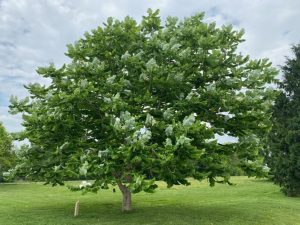
The 1989 movie Steel Magnolias really showed the world that Magnolias, or Southern Magnolias, are a mainstay in the southeastern United States, which it is native to. The dense evergreen tree is medium in size with an average height of 20 feet, although it can grow up to 50 feet high. It has a round top, large, aromatic, cup-shaped, white flowers at the ends of its branches, and smooth, leathery, dark green leaves with rusty brown bottoms. Flowering in summer, it does best in full sun to partial shade and well-drained, rich soil.
Sweet Bay Magnolia
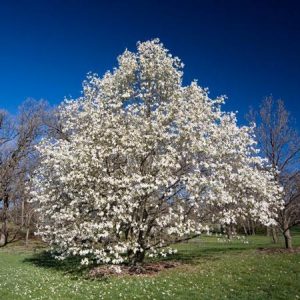
Flowering in late spring to early summer, Sweet Bay Magnolia is native to the southeastern United States. It grows 10 to 20 feet high. Compared to the Southern Magnolia, it likewise has a round top and fragrant, cup-shaped flowers. However, its leaves are sleek and have silvery bottoms, while its flowers are creamy white. Rich, acidic, moist, well-drained soil and full sun to partial shade make it grow well.
Cherry Blossom

The Sakura or Japanese flowering cherry is an ideal front yard tree. With white, pink, or pinkish-white flowers, there are various cultivars which differ in height and size, although it generally grows 15 to 25 feet high. It flowers in the spring. A spreading crown and upright branches show off the clusters of single, double, and semi-double clusters of flowers. Full sun to partial shade with rich, moist, well-drained loams make it thrive.
Native Crabapple
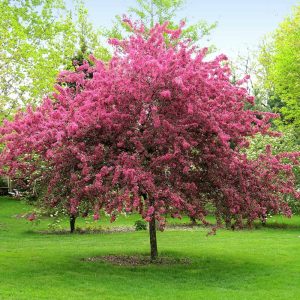
The progenitor of all apple species is extremely tart and sour, akin to the taste of a lemon. It is popular for making jelly and juice when it produces greenish-yellow fruit in the fall. Flowering in spring with a medium size and a height of up to 40 feet, it makes for a great front yard tree with pink-tinged white flower clusters. An irregular, wide-spreading crown, crooked stems, and rough, oval-shaped foliage are also characteristic of this deciduous tree. It grows best in full sun but will also do well in partial shade, but it always needs moist, well-drained, sandy loams.
Redbud
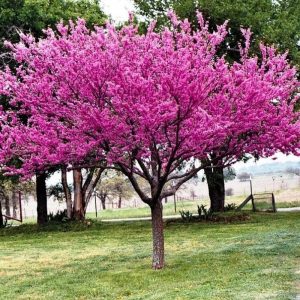
Flowering in summer and growing to heights of 20 to 30 feet, this tree produces strikingly colorful blooms. Its branches are horizontal and it has multiple trunks with heart-shaped leaves, which turn from reddish and dark green to canary yellow in the fall. Small magenta bud clusters become rosy pink. A versatile tree, it grows well in most types of soils and levels of sun exposure.
Smoke Bush Tree

This deciduous shrub is native to southern Europe and central China. An upright shrub with a loosely-spread crown, it has small, yellow flowers on stalks with dusty pink to purplish-pink fine hairs. Oval, blue-green leaves turn purplish-red, orange, and yellow in the fall. It flowers in summer and grows 10 to 15 feet high, thriving in full sun and well-drained, moist and somewhat infertile soils.
Crape Myrtle
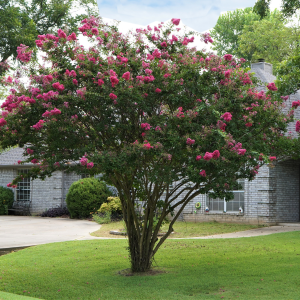
Another Asian tree, the Crape Myrtle is native to Korea and China. Small to medium in size with a height of up to 35 feet, it is commonly called the “lilac of the south” with its huge, purplish-pink flower clusters. Its oval, dark green leaves turn red, orange, and yellow in fall, and it flowers in summer and spring. Tolerating drought, it thrives in moist, well-drained soils and full sun.
Carolina Silverbell
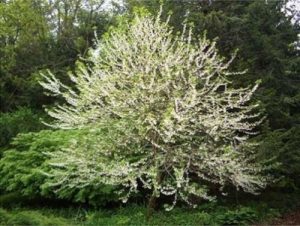
The Carolina Silverbell is another native plant of the southeastern United States. A deciduous, small to medium-sized tree that grows 30 to 40 feet high and flowers in spring, it has a round, spreading crown. Its clusters are two to five white, bell-shaped, drooping flowers with yellow stamens oval-shaped, finely-toothed, dark yellowish-green foliage. If you’re looking for a low-maintenance but striking tree, this one thrives in full sun to partial side with rich, acidic, moist, well-drained soils as well as damp or wet spots.
Scarlet Buckeye
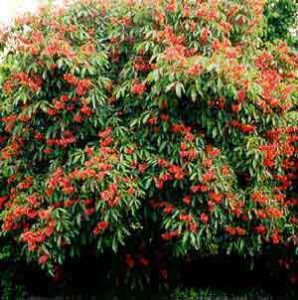
The Scarlet Buckeye is a deciduous shrub that grows 10 to 20 feet high and flowers in spring. Native to southeastern Missouri, it is also called Firecracker Plant or Red Buckeye. It’s great for a woodland edge or shade garden, doing well in moist and damp areas with good drainage and full to partial sun. Its blooms are upright with red or reddish-orange, narrow, tubular blooms that attract hummingbirds, and dark green, shiny, palmately compound leaves.
American Fringe Tree
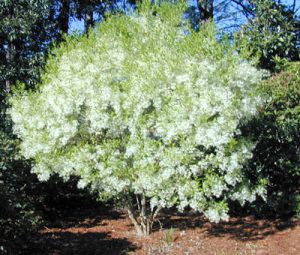
The American Fringe Tree is native to the eastern United States, and is also called Old Man’s Beard or Grancy Gray Beard. The small, deciduous tree grows 12 to 30 feet high and flowers in late spring to early summer. A round, wide-spreading crown produces fringe-shaped, creamy-white blossoms in drooping clusters that produce metallic bluish-black fruit and attract birds. Spear-shaped, wide leaves turn bright yellow in fall. It makes a great front yard or focal point tree and does well in full sun to partial shade with moist, well-drained, rich soils.
Chaste Tree
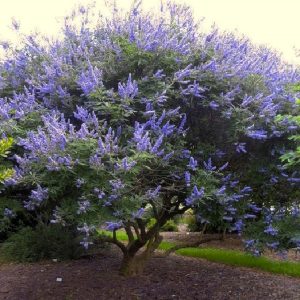
Native to central Asia and southern Europe, the Chaste Tree is a small, multi-trunked tree. It produces fragrant, large, upright, spike-shaped, violet or lavender flower clusters in a wide canopy with fragrant green leaves in five to seven leaflet clusters during the summer and grows 12 to 15 feet high. Great for the patio or driveway, it attracts birds and butterflies. Full sun and moist, well-drained soils make it thrive.
Mountain Gordlinia Sweet Tea
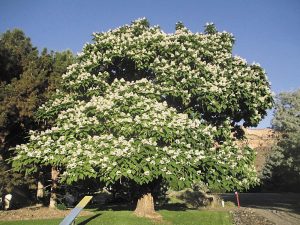
If you want a fast-growing tree, the Mountain Gordlinia Sweet is an excellent choice. It is a hybrid evergreen resulting from a cross between the Franklin Tree and Loblolly Bay. Dark green, serrated, narrow, oval-shaped leaves turn red and orange in fall. Large, partially cupped flowers have five white petals and a bright yellow center full of stamens. It does best with morning sun and afternoon shade. A collectible, it is an alternative to the Franklin Tree, which is hard to grow. It does well in acidic, moist, well-drained soils and full sun to partial shade.
Flowering Plum
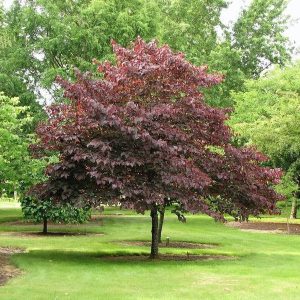
The Flowering Plum is an ornamental tree that blooms early in spring and grows 10 to 20 feet high. Native to China, it has purple-red foliage and round red fruit that contrasts with five-petaled, pinkish-white flowers and wide, oval-shaped, double-toothed, rough, three-lobed green leaves that turn yellow in fall. Full sun to partial shade and well-drained, rich, moist loams are best for it to grow in.

